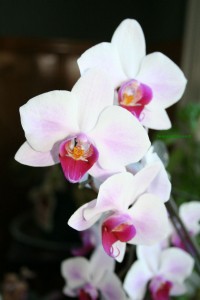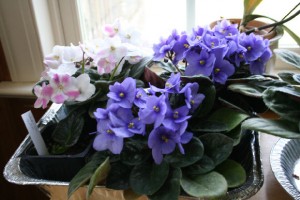One of the most exciting indoor gardening discoveries I’ve made is that if you can grow African violets indoors, you can grow orchids. The two seems to like the same conditions, and appear to be equally as hardy.
When I bought my first orchid, I paid $2 for it. It had a big hole in the leaf and I thought it would die. Instead, it’s been steadily blooming, with only a few short rest periods, since I purchased it three years ago.
What’s my secret? I don’t have any secrets. I water it weekly. It is in a sunny window with bright, diffuse light – northeastern to be exact, the same light requirements that my African violets love. I don’t let it get to hot, cold or dry. The only things I’m aware of that orchids don’t like is bright, direct, hot sunlight. Most houseplant orchids are jungle orchids, and they like a relative humidity of anywhere from 40% to 80%, plus bright but not direct sunlight. That’s ideal for the average home.
The trickiest part of growing orchids for me is keeping the room they are in humid without too much humidity. I keep my books there, too, and I don’t want the humidity to get too high. I accomplish this by keeping my orchids in small trays or pots and adding water to the gravel underneath to keep the local humidity around the plants a bit higher than the room humidity. It seems to work fairly well.
This week, I found more orchids on clearance at Lowe’s. They were past their prime, of course, some in more trouble than others. If you do want to purchase orchid plants from a clearance rack, look for healthy leaves. It’s not terribly important that the plant is finished blooming. Just leave that big stalk sticking out of the top alone; that’s where the plant will make more blossoms. My own plant has been steadily producing new flowers on top of the old stalk for two years now.
Be prepared to give your orchid some TLC if, like me, you purchase one from a discounted shelf. It’s probably been stressed more than the typical greenhouse plant. Many are on the clearance rack because they’ve gotten too dry, or from some other issue. Most seem to be there because they’re just finished blooming and customers prefer plants that are in bloom. Unless you’re a true orchid aficionado, receiving one without a flower isn’t terribly exciting.
The only disappointment you may have with purchasing an orchid that is out of bloom is that the tag may be incorrect and the color you desired isn’t accurate. I already have a white phalenopsis orchid; I am hoping that the one I chose is pink. But if it’s not, it’s not a big deal to me – I will still have another beautiful orchid to add to my plant room.
If you can grow African violets, you can grow orchids. Give them a chance. They aren’t as fragile as they look!






